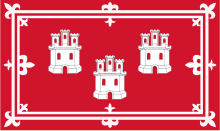Bridge of Dee

The Bridge of Dee or Brig o' Dee is a road bridge over the River Dee in Aberdeen, Scotland. The term is also used for the surrounding area of the city. Dating from 1527,[1] the bridge crosses at what was once the City of Aberdeen's southern boundary. This was the site of a battle in 1639 between the Royalists under Viscount Aboyne and the Covenanters who were led by the Marquess of Montrose and Earl Marischal. This was the only substantial action of the First Bishops' War, ironically it took place after the peace treaty had already been signed.
The Bridge of Dee is approximately 32 feet (10 m) above typical water height and consists of seven nearly semicircular ribbed arches, built using granite and Elgin sandstone. Today the bridge carries the main A90 road into Aberdeen from the south.
Previously listed as a Scheduled monument, it was de-scheduled on 16 February 2009 and designated a Category A listed structure.[2]
History
The bridge was built following a bequest of £20,000 by Bishop William Elphinstone who died in 1514. The bridge was completed by Bishop Gavin Dunbar. It was nearly all rebuilt between 1718 and 1723, and in 1841 was widened from 14 to 26 feet (from four to eight metres) under the direction of Aberdeen City Architect John Smith.[1] Smith also designed the Shakkin' Briggie, and worked on the Bridge of Don with Telford and Wellington Suspension Bridge with Captain Samuel Brown.[3]
The bridge is located near the northern terminus of the Causey Mounth, a medieval drovers' road connecting Stonehaven to Aberdeen. This ancient trackway specifically connected the Bridge of Dee via Bourtreebush, Muchalls Castle and Stonehaven to the south.[4] The route was that taken by William Keith, 7th Earl Marischal and the Marquess of Montrose when they led a Covenanter army of 9000 men in the first battle of the Civil War in 1639.[5]
Until 1832, this was the only access to the city from the south. The bridge still features the original 16th-century piers, coats of arms and passing places.[6]
See also
Footnotes
- 1 2 Richards, J.M., The National Trust Book of Bridges, Jonathan Cape, 1984, ISBN 0-224-02106-0
- ↑ "Stonehaven Road and Anderson Drive South, Bridge of Dee, Ref 20068". Historic Scotland. Retrieved 11 September 2015.
- ↑ "John Smith". Dictionary of Scottish Architects. Retrieved 11 September 2015.
- ↑ C.Michael Hogan, Causey Mounth, Megalithic Portal, ed. Andy Burnham, Nov. 3, 2007
- ↑ Archibald Watt, Highways and Byways around Kincardineshire, Stonehaven Heritage Society (1985)
- ↑ Gazeteer for Scotland. "Bridge of Dee". Retrieved 2007-04-28.
Coordinates: 57°7.38′N 2°7.14′W / 57.12300°N 2.11900°W
